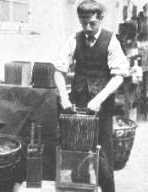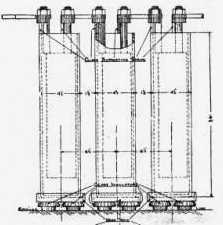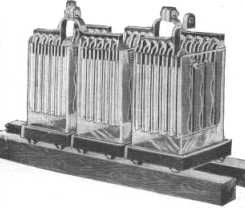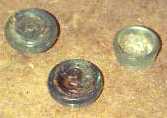HERSTMONCEUX GENERATING WORKS © 1898
ARCHAEOLOGY BATTERIES
Even
by modern standards, the development of accumulators
between 1888 and 1919 had produced a large number of
designs, as manufacturers competed to supply cells that
were easy to maintain and could offer cost effective
operation.
We live in the disposable age and cannot imagine taking a battery apart for servicing. Whereas, it was commonplace to lift out the lead plates and remove the sediment of dislodged lead particles, to extend the operating life of individual cells. Solder repairs to broken terminals came under the heading of regular maintenance.
Servicing
cells
Cells
were arranged in banks on wooden supports to form
batteries of cells.
That is where the term battery comes from. The casing of cells were of sturdy glass. Each
glass case would be balanced on pairs of mushroom shaped
glass discs, to give a clear airspace between casing and
timbers.
It was not usual for a country estate to run generating machinery night and day. This was why a battery store was required. During the day, the generating motors would provide electricity directly to customers
Glass supports
and
also charge the batteries. During the night, when the
engines were
stopped,
lighting current was provided silently by the battery
store. Less
electricity is used at night, so this system worked
well. For
example, at Batemanís, Burwash E. Sussex, Rudyard
Kipling installed a small water-turbine powered dynamo,
which charged a battery store in 1902 sufficient to
supply 10 light bulbs. Kipling
used the limited electricity capacity only for
Hart battery in wooden trays
The cost of each unit of electricity supplied in this way had to include for the depreciation and maintenance of the accumulators. Whereas, with modern power stations, it is more cost effective to run through the night using low cost inducement to U.K. customers; excess power being offloaded across the Channel to Europe.
Glass supports found on site
Herstmonceux Electricity Generating Works Circa. 1900 - 1936 Links:
Introduction | Instructions | ISBN | Batteries | Boiler Room | Floor Plan | Ron Saunders
Industrial Revolution | Lime Park | Machinery | Map | Power House | Argus 1999
Public Supply | Roof Construction | Rural Supply | Sussex Express 1913 | Conclusion
Archaeology South East | East Sussex CC | English Heritage | SIAS | Sx Exp 1999
Memories of Herstmonceux by Margaret Pollard
This website is Copyright © 1999 & 2023. All rights reserved. All other trademarks are hereby acknowledged. Max Energy Limited is an environmental educational charity.



